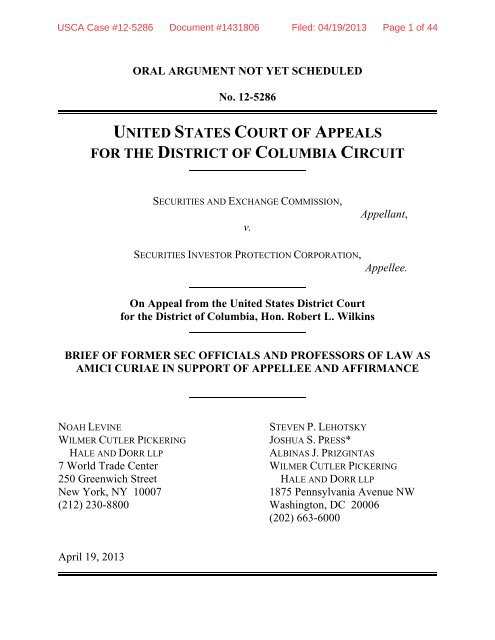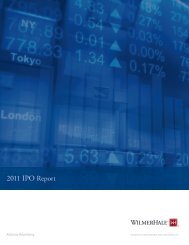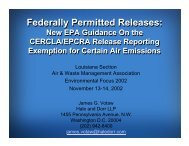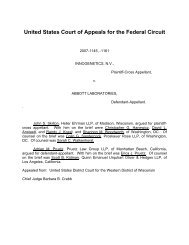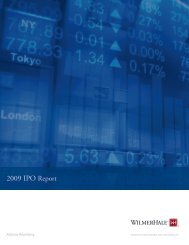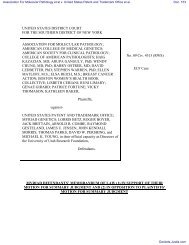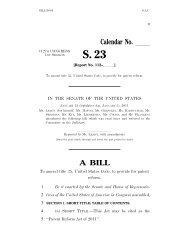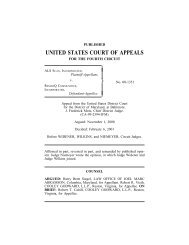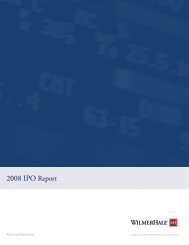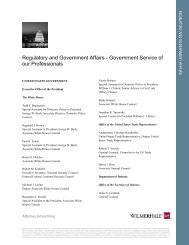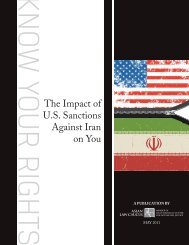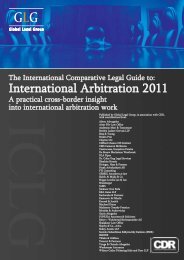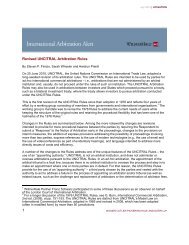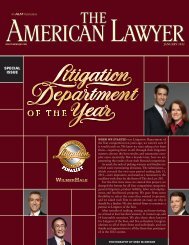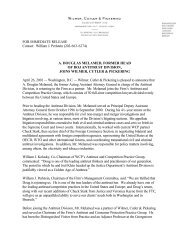amicus brief - WilmerHale
amicus brief - WilmerHale
amicus brief - WilmerHale
You also want an ePaper? Increase the reach of your titles
YUMPU automatically turns print PDFs into web optimized ePapers that Google loves.
USCA Case #12-5286 Document #1431806 Filed: 04/19/2013 Page 1 of 44<br />
ORAL ARGUMENT NOT YET SCHEDULED<br />
No. 12-5286<br />
UNITED STATES COURT OF APPEALS<br />
FOR THE DISTRICT OF COLUMBIA CIRCUIT<br />
SECURITIES AND EXCHANGE COMMISSION,<br />
v.<br />
SECURITIES INVESTOR PROTECTION CORPORATION,<br />
On Appeal from the United States District Court<br />
for the District of Columbia, Hon. Robert L. Wilkins<br />
Appellant,<br />
Appellee.<br />
BRIEF OF FORMER SEC OFFICIALS AND PROFESSORS OF LAW AS<br />
AMICI CURIAE IN SUPPORT OF APPELLEE AND AFFIRMANCE<br />
NOAH LEVINE<br />
WILMER CUTLER PICKERING<br />
HALE AND DORR LLP<br />
7 World Trade Center<br />
250 Greenwich Street<br />
New York, NY 10007<br />
(212) 230-8800<br />
April 19, 2013<br />
STEVEN P. LEHOTSKY<br />
JOSHUA S. PRESS*<br />
ALBINAS J. PRIZGINTAS<br />
WILMER CUTLER PICKERING<br />
HALE AND DORR LLP<br />
1875 Pennsylvania Avenue NW<br />
Washington, DC 20006<br />
(202) 663-6000
USCA Case #12-5286 Document #1431806 Filed: 04/19/2013 Page 2 of 44<br />
CERTIFICATE AS TO PARTIES,<br />
RULINGS, AND RELATED CASES<br />
Parties and Amici<br />
Except for the amici curiae listed below, all parties, intervenors, and amici<br />
appearing before the District Court and this Court are listed in the <strong>brief</strong>s for<br />
Appellant and Appellee:<br />
Appellee.<br />
Former SEC Officials and Professors of Law<br />
Financial Services Institute, Inc.<br />
Securities Industry and Financial Markets Association<br />
Rulings Under Review<br />
Reference to the ruling under review appears in the <strong>brief</strong>s for Appellant and<br />
Related Cases<br />
Reference to the related case in this Court appears in the <strong>brief</strong>s for Appellant<br />
and Appellee.<br />
Statutes and Regulations<br />
All applicable statutes and regulations are set forth in the Addenda to the<br />
<strong>brief</strong>s for Appellant and Appellee.<br />
i
USCA Case #12-5286 Document #1431806 Filed: 04/19/2013 Page 3 of 44<br />
D.C. CIRCUIT 29(d) STATEMENT<br />
Amici curiae Former SEC Officials and Professors of Law—including the<br />
Honorable Joseph A. Grundfest and the Honorable Paul S. Atkins, former<br />
Commissioners of the SEC; the Honorable Simon M. Lorne, former General<br />
Counsel of the SEC; and Professors William J. Carney and Kenneth E. Scott—are<br />
filing a separate <strong>brief</strong> in support of Appellees and affirmance from the Financial<br />
Services Institute, Inc. (FSI) and the Securities Industry and Financial Markets<br />
Association (SIFMA).<br />
Amici are former SEC regulators and highly regarded legal scholars in the<br />
field of securities law and regulation (among many other subjects). This <strong>brief</strong> thus<br />
presents the Court with a perspective gleaned from decades of experience as<br />
securities regulators and scholars. FSI and SIFMA, by contrast, are both<br />
associations of regulated entities that may be either subject to the Securities<br />
Investor Protection Act of 1970 (SIPA), regulated by the SEC, or both: FSI is an<br />
independent association of financial advisors and broker-dealers, and SIFMA is an<br />
association of hundreds of securities firms, banks, and asset managers. Counsel for<br />
Amici understands that the separate <strong>brief</strong>s of FSI and SIFMA will principally<br />
address issues of concern to their members as entities subject to SIPA and<br />
regulated by the SEC.<br />
ii
USCA Case #12-5286 Document #1431806 Filed: 04/19/2013 Page 4 of 44<br />
Counsel for Amici certifies that this separate <strong>brief</strong> amici curiae is necessary<br />
to permit them, as former securities regulators and current academics, to provide<br />
the Court with a historical and contextual perspective on securities regulation.<br />
iii<br />
/s/ Steven P. Lehotsky<br />
STEVEN P. LEHOTSKY<br />
WILMER CUTLER PICKERING<br />
HALE AND DORR LLP<br />
1875 Pennsylvania Avenue NW<br />
Washington, DC 20006<br />
(202) 663-6000<br />
steven.lehotsky@wilmerhale.com
USCA Case #12-5286 Document #1431806 Filed: 04/19/2013 Page 5 of 44<br />
TABLE OF CONTENTS<br />
Page<br />
CERTIFICATE AS TO PARTIES, RULINGS, AND RELATED<br />
CASES .............................................................................................................. i<br />
D.C. CIRCUIT 29(d) STATEMENT ....................................................................... ii<br />
TABLE OF AUTHORITIES .................................................................................... vi<br />
GLOSSARY ............................................................................................................... x<br />
INTEREST OF AMICI CURIAE .............................................................................. 1<br />
SUMMARY OF ARGUMENT ................................................................................. 3<br />
ARGUMENT ............................................................................................................. 5<br />
I. SIPC HAS NO AUTHORITY TO PROVIDE FINANCIAL RELIEF TO<br />
INVESTORS WHO DEPOSITED FUNDS WITH AND RECEIVED CDS<br />
FROM A FOREIGN BANK NOT SUBJECT TO SIPA ............................................. 5<br />
A. The Origins And Context Of SIPA Establish That It Does<br />
Not Protect All Investors ....................................................................... 6<br />
B. SIPA Authorizes SIPC To Protect Only “Customers”<br />
Against The Loss Of Money Or Securities In The<br />
Custody Of Failing Or Insolvent Broker-Dealers ............................... 11<br />
C. The SEC’s Substantive-Consolidation Theory Cannot<br />
Transform SIBL Investors Into SGC “Customers” ............................. 14<br />
D. Neither Primelime Nor Old Naples Provides A Basis To<br />
Conclude That SIBL Investors Are “Customers” Under<br />
SIPA .................................................................................................... 16<br />
II. THE SEC’S INTERPRETATION OF “CUSTOMER” WOULD<br />
RADICALLY TRANSFORM SIPA’S SCOPE AND THREATEN SIPC’S<br />
ABILITY TO FUNCTION AS CONGRESS INTENDED ........................................... 18<br />
iv
USCA Case #12-5286 Document #1431806 Filed: 04/19/2013 Page 6 of 44<br />
III. THE SEC’S INTERPRETATION OF “CUSTOMER” IS NOT ENTITLED<br />
TO DEFERENCE ............................................................................................... 23<br />
A. The SEC’s Memorandum, Adopted In Anticipation Of<br />
Litigation, Deserves No Deference ..................................................... 23<br />
B. SIPC, Not The SEC, Has The Expertise To Interpret<br />
SIPA .................................................................................................... 26<br />
CONCLUSION ........................................................................................................ 30<br />
RULE 32 CERTIFICATION<br />
CERTIFICATE OF SERVICE<br />
v
USCA Case #12-5286 Document #1431806 Filed: 04/19/2013 Page 7 of 44<br />
TABLE OF AUTHORITIES<br />
CASES<br />
Page(s)<br />
American Equity Investment Life Insurance Co. v. SEC, 613 F.3d 166<br />
(D.C. Cir. 2010) ............................................................................................. 18<br />
Bowen v. American Hospital Ass’n, 476 U.S. 610 (1986) ....................................... 29<br />
Business Roundtable v. SEC, 647 F.3d 1144 (D.C. Cir. 2011) ............................... 18<br />
Canada Southern Railway Co. v. Gebhard, 109 U.S. 527 (1883) ........................... 22<br />
Chamber of Commerce v. SEC, 412 F.3d 133 (D.C. Cir. 2005) ............................. 19<br />
*Chevron U.S.A. Inc. v. Natural Resources Defense Council, Inc., 467<br />
U.S. 837 (1984) .............................................................................................. 23<br />
Christensen v. Harris County, 529 U.S. 576 (2000) ............................................... 26<br />
Cunard S.S. Co. v. Salen Reefer Services AB, 773 F.2d 452 (2d Cir.<br />
1985) .............................................................................................................. 22<br />
Fogg v. Ashcroft, 254 F.3d 103 (D.C. Cir. 2001) .................................................... 24<br />
In re Aozora Bank Ltd., 480 B.R. 117 (S.D.N.Y. 2012) .................................... 19, 25<br />
In re Bernard L. Madoff Investment Securities LLC, 654 F.3d 229 (2d<br />
Cir. 2011) ............................................................................................. 5, 12, 19<br />
*In re Bernard L. Madoff Investment Securities LLC, 708 F.3d 422<br />
(2d Cir. 2013) ....................................................................................... 9, 12, 17<br />
In re Brentwood Securities, Inc., 925 F.2d 325 (9th Cir. 1991) .............................. 12<br />
In re Brittenum & Associates, Inc., 82 B.R. 64 (Bankr. E.D. Ark.<br />
1987) .............................................................................................................. 15<br />
*Authorities upon which we chiefly rely are marked with asterisks.<br />
vi
USCA Case #12-5286 Document #1431806 Filed: 04/19/2013 Page 8 of 44<br />
In re Continental Vending Machine Corp., 517 F.2d 997 (2d Cir.<br />
1975) ........................................................................................................ 15, 16<br />
In re New Times Securities Services, Inc., 463 F.3d 125 (2d Cir. 2006) ........... 12, 13<br />
In re New Times Securities Services Inc., 371 F.3d 68 (2d Cir. 2004) .................... 28<br />
In re Old Naples Securities, Inc., 223 F.3d 1296 (11th Cir. 2000) ......................... 16<br />
In re Primeline Securities Corp., 295 F.3d 1100 (10th Cir. 2002) .......................... 16<br />
In re Stalvey & Associates, Inc., 750 F.2d 464 (5th Cir. 1985) ......................... 11, 14<br />
JP Morgan Chase Bank v. Altos Hornos de Mexico, S.A. de C.V., 412<br />
F.3d 418 (2d Cir. 2005) ................................................................................. 23<br />
Koenig v. Smith, 88 F.R.D. 604 (E.D.N.Y. 1980) ................................................... 13<br />
Landmark Legal Foundation v. IRS, 267 F.3d 1132 (D.C. Cir. 2001) .................... 24<br />
Liberty Property Trust v. Republic Properties Corp., 577 F.3d 335<br />
(D.C. Cir. 2009) ............................................................................................. 16<br />
Martin v. Occupational Safety & Health Review Commission, 499<br />
U.S. 144 (1991) .............................................................................................. 24<br />
Miller v. Clinton, 687 F.3d 1332 (D.C. Cir. 2012) .................................................. 24<br />
Pardo v. Wilson Line of Washington, Inc., 414 F.2d 1145 (D.C. Cir.<br />
1969) .............................................................................................................. 15<br />
Pension Benefit Guarantee Corp. v. LTV Corp., 496 U.S. 633 (1990) ................... 27<br />
Price v. Stevedoring Services of America, Inc., 697 F.3d 820 (9th Cir.<br />
2012) .............................................................................................................. 25<br />
Proffitt v. FDIC, 200 F.3d 855 (D.C. Cir. 2000) ..................................................... 29<br />
Public Citizen, Inc. v. HHS, 332 F.3d 654 (D.C. Cir. 2003) ................................... 26<br />
Quinn v. Butz, 510 F.2d 743 (D.C. Cir. 1975) ......................................................... 16<br />
vii
USCA Case #12-5286 Document #1431806 Filed: 04/19/2013 Page 9 of 44<br />
Salleh v. Christopher, 85 F.3d 689 (D.C. Cir. 1996) ............................................... 29<br />
SEC v. Packer, Wilbur & Co., 498 F.2d 978 (2d Cir. 1974) ..................................... 9<br />
SEC v. SIPC, 872 F. Supp. 2d 1 (D.D.C. 2012)......................... 4, 11, 13, 15, 18, 20,<br />
Sepulveda v. Allen Family Foods, Inc., 591 F.3d 209 (4th Cir. 2009) .................... 25<br />
*SIPC v. Barbour, 421 U.S. 412 (1975) ..........................................6, 8, 9, 10, 12, 26<br />
SIPC v. Morgan, Kennedy & Co., 533 F.2d 1314 (2d Cir. 1976) ..................... 19, 20<br />
SIPC v. Vigman, 803 F.2d 1513 (9th Cir. 1986) ...................................................... 13<br />
St. Agnes Hospital v. Sullivan, 905 F.2d 1563 (D.C. Cir. 1990) ............................. 24<br />
Texas Rural Legal Aid, Inc. v. Legal Services Corp., 940 F.2d 685<br />
(D.C. Cir. 1991) ............................................................................................. 27<br />
Touche Ross & Co. v. Redington, 442 U.S. 560 (1979) .......................................... 21<br />
United States v. Mead Corp., 533 U.S. 218 (2001) ........................................... 23, 26<br />
Velazquez v. Legal Services Corp., 164 F.3d 757 (2d Cir. 1999) ............................ 27<br />
Village of Barrington v. STB, 636 F.3d 650 (D.C. Cir. 2011) ................................. 24<br />
STATUTES, RULES, AND LEGISLATIVE MATERIALS<br />
12 U.S.C. § 5385 (Supp. 2010) ................................................................................ 28<br />
15 U.S.C.<br />
§ 78ccc(2) ............................................................................................................ 26<br />
§ 78ccc(a)(1)(A).................................................................................................. 27<br />
§ 78ddd(a)(1) ...................................................................................................... 10<br />
§ 78ddd(c)(3) ...................................................................................................... 20<br />
§ 78ddd(h) ........................................................................................................... 11<br />
§ 78eee .................................................................................................................. 5<br />
§ 78eee(a)(3) ....................................................................................................... 28<br />
§ 78fff(b) ............................................................................................................. 22<br />
§ 78fff-3(a) .......................................................................................................... 10<br />
§ 78fff-3(d) .......................................................................................................... 10<br />
viii
USCA Case #12-5286 Document #1431806 Filed: 04/19/2013 Page 10 of 44<br />
§ 78fff(a) ............................................................................................................. 10<br />
§ 78ggg(c) ........................................................................................................... 26<br />
§ 78lll(2)(A) .................................................................................................... 6, 11<br />
§ 78lll(2)(B)(i) .............................................................................................. 11, 15<br />
§ 78lll(2)(C)(ii) ................................................................................................... 15<br />
§ 78lll(7) .................................................................................................. 13, 14, 15<br />
Securities Investor Protection Act of 1970, Pub. L. No. 91-598, 84 Stat.<br />
1636 (codified at 15 U.S.C. §§ 76aaa et seq.) ...................................................... 9<br />
Fed. R. App. P<br />
Rule 29(a) .............................................................................................................. 2<br />
Rule 29(c)(5) ......................................................................................................... 2<br />
D.C. Cir. R. 29(b) ....................................................................................................... 2<br />
H.R. Rep. No. 91-1613 (1970) ................................................................................... 7<br />
H.R. Rep. No. 92-1519 (1972) ....................................................................... 6, 7, 8, 9<br />
S. Rep. No. 91-1218 (1970) ....................................................................................... 8<br />
S. Rep. No. 95-763 (1978) ................................................................................. 10, 26<br />
The Securities Investor Protection Corporation: Past, Present, and Future:<br />
Hearing Before Subcomm. on Capital Markets & Government Sponsored<br />
Enterprises of the H. Comm. on Financial Services, 112th Cong. (2012) ......... 11<br />
OTHER AUTHORITIES<br />
2011 SIPC Annual Report, available at http://www.sipc.org/Portals/0/PDF/<br />
2011_Annual_Report.pdf ................................................................................... 20<br />
Collier on Bankruptcy (16th ed. 2012) .............................................. 9, 10, 12, 15, 22<br />
Don, Michael E., & Josephine Wang, Stockbroker Liquidations Under the<br />
Securities Investor Protection Act and Their Impact on Securities<br />
Transfers, 12 Cardozo L. Rev. 509 (1990) ....................................................... 7, 8<br />
FBI Financial Crimes Report to the Public, Fiscal Year 2006, available at<br />
http://www.fbi.gov/stats-services/publications/fcs_report2006. ........................ 20<br />
ix
USCA Case #12-5286 Document #1431806 Filed: 04/19/2013 Page 11 of 44<br />
Joo, Thomas W., Who Watches the Watchers?, 72 S. Cal. L. Rev. 1071<br />
(1999) .................................................................................................... 7, 8, 21, 22<br />
Hazen, Thomas L., Law of Securities Regulation (6th ed. 2009) ............................ 28<br />
Loss, Louis, Securities Regulation (4th ed. 2006) ................................................... 12<br />
Seligman, Joel, The Transformation of Wall Street (3d ed. 2003) .................... 7, 8, 9<br />
x
USCA Case #12-5286 Document #1431806 Filed: 04/19/2013 Page 12 of 44<br />
GLOSSARY<br />
CD Certificate of Deposit<br />
FSI Financial Services Institute, Inc.<br />
SEC Securities and Exchange Commission<br />
SGC Stanford Group Company<br />
SIBL Stanford International Bank Ltd.<br />
SIFMA Securities Industry and Financial Markets Association<br />
SIPA Securities Investor Protection Act of 1970<br />
SIPC Securities Investor Protection Corporation<br />
xi
USCA Case #12-5286 Document #1431806 Filed: 04/19/2013 Page 13 of 44<br />
INTEREST OF AMICI CURIAE<br />
Amici curiae are two former Commissioners of the SEC, a former General<br />
Counsel of the SEC, as well as two highly regarded law professors with expertise<br />
in securities law and regulation, capital markets, corporate governance, and<br />
corporate finance. Amici have devoted much of their careers to securities law and<br />
regulation—including the drafting, implementation, and interpretation of federal<br />
securities laws—with a view toward promoting efficient and competitive capital<br />
markets while protecting investors. Amici thus provide the Court with a historical<br />
and contextual perspective on securities regulation and investor protection, gleaned<br />
from decades of experience as regulators and academics, which the Court may<br />
consider in deciding the novel question regarding the interpretation of the<br />
Securities Investor Protection Act of 1970 (SIPA) presented in this case.<br />
Amici have no personal interest, whether financial or professional, in the<br />
outcome of this case and represent no party either directly or indirectly. This <strong>brief</strong><br />
is submitted solely as a friend of the court and addresses whether the District Court<br />
correctly rejected Appellant’s claim that investors who purchased and received<br />
certificates of deposit from a foreign bank should be “deemed” customers of a<br />
registered broker-dealer under SIPA. In light of the experience and expertise of<br />
the amici, this <strong>brief</strong> reflects their consensus view that this Court should affirm the<br />
1
USCA Case #12-5286 Document #1431806 Filed: 04/19/2013 Page 14 of 44<br />
District Court’s judgment. 1 Each individual <strong>amicus</strong>, however, may not endorse<br />
every argument presented in this <strong>brief</strong>.<br />
The amici joining this <strong>brief</strong> are listed below:<br />
The Honorable Joseph A. Grundfest served as a Commissioner of the SEC<br />
from 1985 to 1990. He is currently the W. A. Franke Professor of Law and<br />
Business at Stanford Law School. Professor Grundfest is a nationally prominent<br />
expert on securities litigation and regulation, capital markets, and corporate<br />
governance.<br />
The Honorable Paul S. Atkins served as a Commissioner of the SEC from<br />
2002 to 2008, during which he advocated better transparency and consistency in<br />
the SEC’s decisionmaking and enforcement activities, as well as smarter regulation<br />
that considers costs and benefits. Mr. Atkins is currently the Chief Executive<br />
Officer of Patomak Global Partners, LLC (a specialized consulting firm), and is an<br />
independent director and non-executive Chairman of the Board of BATS Global<br />
Markets, Inc. (a leading operator of securities markets in the United States and<br />
Europe).<br />
1<br />
Counsel for Appellant the Securities and Exchange Commission and<br />
Counsel for Appellee the Securities Investor Protection Corporation consent to the<br />
filing of this <strong>brief</strong>. See Fed. R. App. P. 29(a); D.C. Cir. R. 29(b).<br />
No party’s counsel authored this <strong>brief</strong> in whole or in part, and no person—<br />
other than amici curiae or their counsel—contributed money that was intended to<br />
fund preparing or submitting this <strong>brief</strong>. See Fed. R. App. P. 29(c)(5).<br />
2
USCA Case #12-5286 Document #1431806 Filed: 04/19/2013 Page 15 of 44<br />
The Honorable Simon M. Lorne served as the General Counsel of the SEC<br />
from 1993 to 1996. He is currently the Vice Chairman and Chief Legal Officer of<br />
Millennium Management LLC (a global investment firm), a Co-Director of<br />
Stanford Law School’s Directors’ College, and an adjunct professor at New York<br />
University School of Law.<br />
Professor William J. Carney is the Charles Howard Candler Professor<br />
Emeritus of Law at Emory Law School. He has expertise in the fields of business<br />
associations, securities regulation, and corporate law and is the author of two<br />
leading casebooks, Corporate Finance and Mergers and Acquisitions, as well as<br />
several other books and more than 50 articles and book chapters.<br />
Professor Kenneth E. Scott is the Ralph M. Parsons Professor of Law and<br />
Business Emeritus at Stanford Law School and a senior research fellow at the<br />
Hoover Institution. He has expertise in banking and financial institutions and<br />
securities regulation and is a leading scholar in the fields of corporate finance<br />
reform and corporate governance. Professor Scott has written extensively on<br />
federal deposit insurance issues and federal banking regulation.<br />
SUMMARY OF ARGUMENT<br />
The Securities and Exchange Commission seeks to force the Securities<br />
Investor Protection Corporation (SIPC) to initiate a liquidation of Stanford Group<br />
Company (SGC), a SIPC-member broker-dealer, for the benefit of investors who<br />
3
USCA Case #12-5286 Document #1431806 Filed: 04/19/2013 Page 16 of 44<br />
purchased and received certificates of deposit (CDs) from Stanford International<br />
Bank Ltd. (SIBL), an Antiguan bank. See SEC v. SIPC, 872 F. Supp. 2d 1, 2-3<br />
(D.D.C. 2012). The investors lent money to the offshore bank, which is a foreign<br />
institution that is not a member of SIPC and was not subject to regulation under<br />
United States law. Yet the SEC contends that the investors should be “deemed” to<br />
be “customers” of the domestic broker-dealer under SIPA.<br />
The SEC’s efforts to so dramatically expand the scope of persons covered<br />
through SIPC should be rejected for at least three distinct reasons. First, the SEC’s<br />
proposal to “deem” purchasers of CDs issued by a foreign bank to be “customers”<br />
of a domestic broker-dealer contravenes the plain language of the statute, conflicts<br />
with the relevant statutory history, and is at odds with more than 40 years of<br />
judicial precedent.<br />
Second, the SEC’s unwarranted expansion of the definition of the term<br />
“customer” would substantially increase the financial exposure of the SIPC Fund.<br />
Yet the SEC has presented no economic analysis considering the financial<br />
implications of this expanded coverage for (1) the industry that must pay fees in<br />
order to support the SIPC Fund; (2) the United States Treasury, which is statutorily<br />
required to provide a line of credit to help support the SIPC Fund (which line of<br />
credit is more likely to be drawn down if the scope of coverage is expanded as the<br />
SEC requests); and (3) the federal taxpayers who might be called upon to bear<br />
4
USCA Case #12-5286 Document #1431806 Filed: 04/19/2013 Page 17 of 44<br />
some of these potential losses. The SEC’s proposed expansion of SIPC protection,<br />
absent even the most rudimentary consideration of any financial consequences,<br />
would radically transform SIPA and threaten SIPC’s ability to function as<br />
Congress intended.<br />
Third, the SEC’s proposed redefinition of the term “customer” does not<br />
warrant Chevron deference. Where a statute is administered by more than one<br />
entity, no single entity can claim Chevron deference. Here, the relevant statute is<br />
also administered by SIPC, a body governed by a seven-member board composed<br />
of presidential and executive branch appointees. SIPC’s views are diametrically<br />
opposed to the SEC’s and, given the facts and circumstances of these proceedings,<br />
should be accorded more deference.<br />
Therefore, Amici respectfully submit that the Court should reject the SEC’s<br />
unprecedented interpretation of the term “customer” and affirm the District Court’s<br />
judgment.<br />
ARGUMENT<br />
I. SIPC HAS NO AUTHORITY TO PROVIDE FINANCIAL RELIEF TO INVESTORS<br />
WHO DEPOSITED FUNDS WITH AND RECEIVED CDS FROM A<br />
FOREIGN BANK NOT SUBJECT TO SIPA<br />
As SIPA’s plain language makes clear, to be eligible for SIPC’s protection,<br />
an investor must first qualify as a “customer” of a SIPC-member broker-dealer. 15<br />
U.S.C. § 78eee; see In re Bernard L. Madoff Inv. Sec. LLC, 654 F.3d 229, 236 (2d<br />
5
USCA Case #12-5286 Document #1431806 Filed: 04/19/2013 Page 18 of 44<br />
Cir. 2011) (if claimants “are not ‘customers,’ 15 U.S.C. § 78lll(2)(A), they are not<br />
entitled to the protection of SIPA at all”). The District Court correctly rejected the<br />
SEC’s argument that SIPC was obligated to liquidate SGC for the protection of<br />
investors who purchased and received SIBL CDs because those investors were not<br />
“customers” of SGC. There is no statutory or legal basis for the SEC’s novel<br />
theory that SIPC’s obligations apply wherever a customer may be “deemed” to be<br />
a customer (even though not, in fact, actually a customer).<br />
A. The Origins And Context Of SIPA Establish That It Does Not<br />
Protect All Investors<br />
“Customer,” as defined by SIPA, is a term of art, narrowly crafted by<br />
Congress in response to a crisis in the late 1960s in which “customers” of failed<br />
broker-dealers “found their cash and securities on deposit either dissipated or tied<br />
up in lengthy bankruptcy proceedings.” SIPC v. Barbour, 421 U.S. 412, 415<br />
(1975). The circumstances of that crisis and the contemporaneous history of<br />
SIPA’s enactment in the early 1970s are instructive in understanding the context in<br />
which Congress established an investor-protection scheme that was limited to<br />
“customers.”<br />
The period of 1967 to 1970 “was one of crisis for the securities industry and<br />
for the investing public.” H.R. Rep. No. 92-1519, at 3 (1972). The crisis had two<br />
phases: first, a back-office crisis, during which “the so-called paperwork problem<br />
was predominant”; and second, “a period of financial distress during which many<br />
6
USCA Case #12-5286 Document #1431806 Filed: 04/19/2013 Page 19 of 44<br />
firms reached the brink of disaster and many, in fact, failed, causing financial<br />
hardship for the public investors whom they served.” Id.; see Seligman, The<br />
Transformation of Wall Street 450-452 (3d ed. 2003).<br />
From 1967 to 1969, “‘brokerage firms [found] themselves in the paradox of<br />
being forced out of business by having too much business.’” Seligman, supra,<br />
at 451 (alteration in original). The securities industry had experienced “a period of<br />
great expansion in the 1960s,” Barbour, 421 U.S. at 415, but brokerage firms had<br />
failed to upgrade their back-office infrastructures, see H.R. Rep. No. 92-1519, at 4-<br />
6. Firms “concentrated on exploiting demand … by expanding their sales forces,”<br />
but “were slow to automate their back office procedures and continued to rely on<br />
outdated methods.” Joo, Who Watches the Watchers?, 72 S. Cal. L. Rev. 1071,<br />
1076 (1999); see Don & Wang, Stockbroker Liquidations Under the Securities<br />
Investor Protection Act and Their Impact on Securities Transfers, 12 Cardozo L.<br />
Rev. 509, 510-511 (1990). “Thus, firms accepted more and more trade orders<br />
while failing to upgrade their ‘back offices’—the personnel and facilities for trade<br />
processing and record-keeping.” Joo, 72 S. Cal. L. Rev., at 1076-1077.<br />
Broker-dealers were “responsible for safeguarding billions of dollars in cash<br />
and securities which belong to investors.” H.R. Rep. No. 91-1613, at 2 (1970).<br />
But the outdated and understaffed back offices were quickly overwhelmed:<br />
“‘Stock certificates and related documents were piled “halfway to the ceiling” in<br />
7
USCA Case #12-5286 Document #1431806 Filed: 04/19/2013 Page 20 of 44<br />
some offices; clerical personnel were working overtime, six and seven days a<br />
week, with some firms using a second or even a third shift to process each day’s<br />
transactions.’” Seligman, supra, at 451. “[W]orking conditions deteriorated,”<br />
H.R. Rep. No. 92-1519, at 4, “[e]rrors were rampant and chaos ensued as a result<br />
of the failure of record-keeping procedures,” Joo, 72 S. Cal. L. Rev., at 1077.<br />
Broker-dealers commonly lost securities or otherwise failed to complete<br />
trades and deliver funds or securities. See S. Rep. No. 91-1218, at 3 (1970); H.R.<br />
Rep. No. 92-1519, at 5-6. In 1969, there were 12,494 customer complaints to the<br />
SEC, 90% of which described back-office problems, “‘particularly the failure to<br />
deliver customer funds and securities’ in a timely manner.” Seligman, supra, at<br />
451. And instances of malfeasance, such as the theft of securities from broker-<br />
dealers, multiplied. See S. Rep. No. 91-1218, at 3. In short, there was an<br />
“industrywide loss of control of recordkeeping procedures,” Seligman, supra,<br />
at 451, and an ensuing loss or theft of customer funds and securities, Don & Wang,<br />
12 Cardozo L. Rev., at 511.<br />
Beginning in 1969 and continuing into 1970, just as brokerage firms were<br />
slowly beginning to update their methods of tracking and processing trades, “the<br />
securities industry experienced a business contraction that led to the failure or<br />
instability of a significant number of brokerage firms.” Barbour, 421 U.S. at 415;<br />
see S. Rep. No. 91-1218, at 3. “The securities industry’s prolonged unprofitability,<br />
8
USCA Case #12-5286 Document #1431806 Filed: 04/19/2013 Page 21 of 44<br />
coupled with the financial losses created by the … back-office operations<br />
breakdown, set in motion the greatest rash of broker-dealer firm failures in Wall<br />
Street’s history.” Seligman, supra, at 452; see H.R. Rep. No. 92-1519, at 1.<br />
Congress responded by enacting SIPA, an act with the stated aim of “provid[ing]<br />
greater protection for customers of registered brokers and dealers and members of<br />
national securities exchanges.” Securities Investor Protection Act of 1970, Pub. L.<br />
No. 91-598, 84 Stat. 1636 (codified at 15 U.S.C. §§ 76aaa et seq.).<br />
“SIPA was not designed to provide full protection to all victims of a<br />
brokerage collapse.” SEC v. Packer, Wilbur & Co., 498 F.2d 978, 983 (2d Cir.<br />
1974). In enacting SIPA, Congress responded to the precise crisis confronting it:<br />
“Customers of failed firms found their cash and securities on deposit either<br />
dissipated or tied up in lengthy bankruptcy proceedings.” Barbour, 421 U.S.<br />
at 415. SIPA’s purpose is therefore carefully delineated and limited to protecting<br />
only “customers of failing broker-dealers with whom they had left cash or<br />
securities on deposit.” Id. at 413; see In re Bernard L. Madoff Inv. Sec. LLC, 708<br />
F.3d 422, 426 (2d Cir. 2013); see also 1-12 Collier on Bankruptcy 12.01, at 12-4<br />
(16th ed. 2012) (SIPA protects “against losses stemming from the failure of an<br />
insolvent or otherwise failed broker-dealer to properly perform its role as the<br />
custodian of customer cash and securities.”).<br />
9
USCA Case #12-5286 Document #1431806 Filed: 04/19/2013 Page 22 of 44<br />
As its central feature, SIPA created “a new form of liquidation proceeding,<br />
applicable only to member firms, designed to accomplish the completion of open<br />
transactions and the speedy return of most customer property.” Barbour, 421 U.S.<br />
at 416. The Act contemplates the distribution of “customer name securities” and<br />
“customer property” “as promptly as possible.” 15 U.S.C. § 78fff(a). Unlike “the<br />
stockbroker liquidation provisions of the Bankruptcy Code, which require that<br />
customer securities be reduced to cash, to the greatest extent practicable, SIPA<br />
requires the satisfaction of customer claims for securities through the distribution<br />
of securities.” 1-12 Collier on Bankruptcy 12.02, at 12-7.<br />
Congress created SIPC as a nonprofit, private membership corporation to<br />
which most registered broker-dealers are required to belong, for the purpose of<br />
“administer[ing] SIPA through statutory assessments of SIPC members.” S. Rep.<br />
No. 95-763, at 1 (1978); see Barbour, 412 U.S. at 415-416. And Congress<br />
established the “SIPC Fund,” 15 U.S.C. § 78ddd(a)(1), “a substantial reserve fund<br />
in order to provide financial protection to the customers of SIPC-member broker-<br />
dealers,” 1-12 Collier on Bankruptcy 12.03[2], at 12-15.<br />
Through the SIPC Fund, every customer of a SIPC-member is protected up<br />
to $500,000 against the loss of securities (including up to $250,000 for cash)<br />
deposited with the broker-dealer for that customer’s account. 15 U.S.C. § 78fff-<br />
3(a), (d). If the SIPC Fund becomes inadequate for the purposes of SIPA, SIPC<br />
10
USCA Case #12-5286 Document #1431806 Filed: 04/19/2013 Page 23 of 44<br />
may borrow, through the SEC and against the United States Treasury, up to $2.5<br />
billion. Id. § 78ddd(h). Since its creation in 1970, however, “SIPC has never<br />
drawn on that line of credit.” The Securities Investor Protection Corporation:<br />
Past, Present, and Future: Hearing Before Subcomm. on Capital Markets &<br />
Government Sponsored Enterprises of the H. Comm. on Financial Services, 112th<br />
Cong. 12 (2012) (statement of Sharon Y. Bowen, Acting Chair of SIPC).<br />
B. SIPA Authorizes SIPC To Protect Only “Customers” Against<br />
The Loss Of Money Or Securities In The Custody Of Failing Or<br />
Insolvent Broker-Dealers<br />
“‘Customer’ … is a statutorily defined term of art as used in SIPA.” In re<br />
Stalvey & Assocs., Inc., 750 F.2d 464, 468 (5th Cir. 1985) (Wisdom, J.). “It is not<br />
used in the colloquial sense of ‘one who buys and trades,’” but rather is “meant as<br />
a shorthand designation for those eligible under SIPA to receive special protection<br />
for their investments.” Id. Specifically, the Act defines a “customer” of a SIPC-<br />
member broker-dealer to mean:<br />
any person … who has a claim on account of securities received,<br />
acquired, or held by the debtor in the ordinary course of its business as<br />
a broker or dealer from or for the securities accounts of such person<br />
for safekeeping, with a view to sale, to cover consummated sales,<br />
pursuant to purchases, as collateral, security, or for purposes of<br />
effecting transfer.<br />
15 U.S.C. § 78lll(2)(A). This definition is further refined to include, as relevant<br />
here, “any person who has deposited cash with the debtor for the purpose of<br />
purchasing securities.” Id. § 78lll(2)(B)(i); see SIPC, 872 F. Supp. 2d at 7 (SEC<br />
11
USCA Case #12-5286 Document #1431806 Filed: 04/19/2013 Page 24 of 44<br />
stipulated that it relies only on “investors’ deposit of funds for the purchase of<br />
SIBL CDs” in support of its claim that such investors qualify as “customers” under<br />
SIPA).<br />
“‘[J]udicial interpretations of “customer” status support a narrow<br />
interpretation of SIPA’s provisions.’” In re Bernard L. Madoff Inv. Sec. LLC, 708<br />
F.3d at 426 (quoting In re New Times Sec. Servs., Inc., 463 F.3d 125, 127 (2d Cir.<br />
2006)). The “‘critical aspect of the “customer” definition’” is “‘the entrustment of<br />
cash or securities to the broker-dealer for the purposes of trading securities.’” Id.<br />
(quoting In re Bernard L. Madoff Inv. Sec. LLC, 654 F.3d 229, 236 (2d Cir. 2011));<br />
In re Brentwood Sec., Inc., 925 F.2d 325, 327 (9th Cir. 1991) (“An investor is<br />
entitled to compensation from the SIPC only if he has entrusted cash or securities<br />
to a broker-dealer who becomes insolvent[.]”). As the Supreme Court recognized<br />
long ago, SIPA “provid[es] financial relief to the customers of failing broker-<br />
dealers with whom they had left cash or securities on deposit.” Barbour, 421 U.S.<br />
at 414 (emphasis added). 2<br />
2 See also Loss et al., VII Securities Regulation 254 (4th ed. 2006)<br />
(“[C]ustomer” under SIPA “consistently has been construed to include persons<br />
who entrust either cash or securities to a broker-dealer for securities trading, but<br />
does not include persons who lend cash or securities to broker-dealers for other<br />
purposes”); 1-12 Collier on Bankruptcy 12.12[2], at 12-50 (“Under the ‘bright-<br />
line rule’ applied by courts, a claimant will not be entitled to customer protection<br />
under SIPA unless the debtor actually receives the claimant’s cash or securities;<br />
the debtor must actually have come into possession or control.”).<br />
12
USCA Case #12-5286 Document #1431806 Filed: 04/19/2013 Page 25 of 44<br />
Customer status under SIPA is determined as of the statutorily defined<br />
“filing date,” which is usually the date on which SIPC files its application to place<br />
a failing or failed broker-dealer into liquidation, but is sometimes even earlier,<br />
relating back to the date of a receiver’s appointment. See 15 U.S.C. § 78lll(7); see<br />
also In re New Times Sec. Servs., 463 F.3d at 128-129; SIPC v. Vigman, 803 F.2d<br />
1513, 1517 n.1 (9th Cir. 1986). The investors in SIBL’s CDs had no cash or<br />
securities on deposit with SGC—the only SIPC-member broker-dealer at issue in<br />
this case—at the time SGC failed. See SIPC, 872 F. Supp. 2d at 7. Accordingly,<br />
the SEC does not seek the return of any cash on deposit with SGC for the purpose<br />
of purchasing SIBL CDs because there is none—it is undisputed that the investors<br />
in SIBL CDs had purchased and received those CDs at the time SGC failed. See<br />
id. 3 Instead, the SEC essentially seeks to force SIPC to generate rescission<br />
damages for CDs already purchased and received. See Koenig v. Smith, 88 F.R.D.<br />
604, 608 (E.D.N.Y. 1980) (rescission damages remedy “‘the evil … of being<br />
induced to buy’”). But SIPC has no such authority. See Vigman, 803 F.2d at 1517<br />
n.1 (“[I]f a broker used fraudulent means to convince a customer to purchase a<br />
stock and the customer left that stock with the broker, who subsequently became<br />
3 As the SEC has stipulated in this litigation: “Most SGC investors either<br />
received the physical CD certificates or had them held by an authorized designee,<br />
including Stanford Trust Company. To the extent that some SIBL CD investors<br />
did not receive the physical certificates, the SEC is not relying on that fact to<br />
support its claims in this proceeding.” SIPC, 872 F. Supp. 2d at 7.<br />
13
USCA Case #12-5286 Document #1431806 Filed: 04/19/2013 Page 26 of 44<br />
insolvent, SIPC would be required by SIPA only to return the stock to the<br />
customer.”).<br />
C. The SEC’s Substantive-Consolidation Theory Cannot Transform<br />
SIBL Investors Into SGC “Customers”<br />
Because SIBL investors had no funds on deposit with SGC for the purchase<br />
of securities at the time SGC failed, the SEC argues that such investors should be<br />
“deemed to have deposited funds” with SGC. Br. 44 (emphasis added). Relying<br />
on the bankruptcy doctrine of substantive consolidation, the SEC asserts that SGC<br />
and SIBL “were operated in a highly interconnected manner and corporate<br />
formalities were not respected,” id. at 46, such that a deposit of funds with SIBL<br />
should become an “effective[] deposit[]” with SGC, id. at 45, thereby rendering<br />
such investors “customers” of SGC under SIPA. The SEC’s argument is without<br />
statutory merit, for several reasons.<br />
First, the SEC ignores the issue of timing. The rule is not “[o]nce a<br />
customer, always a customer.” In re Stalvey & Assocs., Inc., 750 F.2d at 470. As<br />
discussed above, see supra p. 13, customer status under SIPA is determined as of<br />
the “filing date,” usually the date on which SIPC files its application to place a<br />
failing or failed broker-dealer into liquidation. See 15 U.S.C. § 78lll(7). Even if<br />
consolidation were appropriate, the question for purposes of determining customer<br />
status is whether a SIBL investor could be deemed to have “deposited cash with<br />
the” consolidated-debtor entity “for the purpose of purchasing securities,” id.<br />
14
USCA Case #12-5286 Document #1431806 Filed: 04/19/2013 Page 27 of 44<br />
§ 78lll(2)(B)(i), at the time SGC failed, id. § 78lll(7). The answer is no: Neither<br />
SGC nor SIBL held any investors’ funds on deposit for the purchase of securities<br />
at the time SGC failed. On the contrary, the SEC has stipulated that SIBL<br />
investors purchased and received their CDs. See SIPC, 872 F. Supp. 2d at 7.<br />
Second, SIPA expressly excludes from its definition of “customer” any<br />
person whose “claim for cash or securities … is part of the capital of the debtor,”<br />
whether “by contract, agreement, or understanding, or by operation of law[.]” 15<br />
U.S.C. § 78lll(2)(C)(ii). If SGC and SIBL were consolidated, funds given to that<br />
consolidated entity by SIBL investors for CDs would become part of its capital,<br />
such that those investors would be expressly precluded from qualifying as<br />
customers by statute. Cf. In re Brittenum & Assocs., Inc., 82 B.R. 64, 68 (Bankr.<br />
E.D. Ark. 1987) (those who invest “in the debtor”—rather than “through the<br />
debtor”—are not entitled to SIPA protection).<br />
Third, on its own terms substantive consolidation is unwarranted here. It is<br />
established that substantive consolidation, through veil-piercing, should be “‘used<br />
sparingly.’” In re Cont’l Vending Mach. Corp., 517 F.2d 997, 1001 (2d Cir. 1975);<br />
Pardo v. Wilson Line of Wash., Inc., 414 F.2d 1145, 1149 (D.C. Cir. 1969)<br />
(“Piercing a corporate veil is a task which a court undertakes reluctantly[.]”); 1-12<br />
Collier on Bankruptcy 12.02, at 12-7 n.11 (“There is nearly unanimous consensus<br />
among Courts of Appeal that substantive consolidation is a remedy to be used<br />
15
USCA Case #12-5286 Document #1431806 Filed: 04/19/2013 Page 28 of 44<br />
sparingly.” (quotations omitted)). “The power to consolidate is one arising out of<br />
equity, enabling a bankruptcy court to disregard separate corporate entities, to<br />
pierce their corporate veils in the usual metaphor, in order to reach assets for the<br />
satisfaction of debts of a related corporation.” In re Cont’l Vending Mach. Corp.,<br />
517 F.2d at 1000 (emphasis added). Here, however, the SEC is inappropriately<br />
attempting to use this equitable doctrine to expand the scope of a statutory term<br />
and impose new liabilities on SIPC—an unrelated third party. Cf. Liberty Prop.<br />
Trust v. Republic Props. Corp., 577 F.3d 335, 340 (D.C. Cir. 2009) (veil piercing<br />
is a “‘step to be taken cautiously’” and is not typically used to resolve questions of<br />
statutory interpretation (quoting Quinn v. Butz, 510 F.2d 743, 759 (D.C. Cir.<br />
1975))).<br />
D. Neither Primelime Nor Old Naples Provides A Basis To Conclude<br />
That SIBL Investors Are “Customers” Under SIPA<br />
The SEC contends that even if this Court were to reject its substantive-<br />
consolidation argument, it could still conclude that the SIBL investors qualify as<br />
“customers” of SGC under the agency-theory rationale set forth in In re Primeline<br />
Securities Corp., 295 F.3d 1100 (10th Cir. 2002), and In re Old Naples Securities,<br />
Inc., 223 F.3d 1296 (11th Cir. 2000). Neither case supports the SEC’s position.<br />
As the Second Circuit recently described, in both Primeline and Old Naples,<br />
“the claimants provided money to an ostensible agent of a broker-debtor for the<br />
purpose of investing their money through the broker-debtor, but the agent instead<br />
16
USCA Case #12-5286 Document #1431806 Filed: 04/19/2013 Page 29 of 44<br />
misappropriated the funds.” In re Bernard L. Madoff Inv. Sec. LLC, 708 F.3d at<br />
428. The courts in Primeline and Old Naples “concluded that the claimants were<br />
‘customers’ of the broker-debtor because, in each case, they intended to deposit<br />
their money with the broker-debtor; they followed the agent’s instructions for<br />
doing so; and, at least in Old Naples, the broker-debtor ultimately acquired control<br />
over the claimants’ funds.” Id.<br />
In contrast, the SEC’s own analysis—set forth in the memorandum giving<br />
rise to this litigation—concluded that the “investors with accounts at SGC who<br />
purchased SIBL CDs deposited funds with SIBL” and “clearly had the purpose of<br />
purchasing SIBL CDs.” Analysis of Securities Investor Protection Act Coverage<br />
for Stanford Group Company at 7, Dec. 12, 2011, ECF No. 1-3 (emphasis added).<br />
And the disclosure statements for the SIBL CDs expressly stated that those<br />
deposits were not covered by SIPC, see SIBL Disclosure Statement at 4, Feb. 16,<br />
2012, ECF No. 23-6, and that SIBL was “solely responsible” for “all amounts due<br />
in respect of the CD Deposit,” id. at 17.<br />
Unlike in Primeline and Old Naples, the SIBL investors could not<br />
reasonably have thought that their funds were left on deposit with SGC, given that<br />
they had obtained SIBL CDs. See In re Bernard L. Madoff Inv. Sec. LLC, 708 F.3d<br />
at 428. Thus, the District Court correctly concluded that the SEC’s argument<br />
“seeks to expand ‘customer’ status even beyond the circumstances that were<br />
17
USCA Case #12-5286 Document #1431806 Filed: 04/19/2013 Page 30 of 44<br />
present in Old Naples and Primeline,” and should be rejected. SIPC, 872 F. Supp.<br />
2d at 11.<br />
II. THE SEC’S INTERPRETATION OF “CUSTOMER” WOULD RADICALLY<br />
TRANSFORM SIPA’S SCOPE AND THREATEN SIPC’S ABILITY TO<br />
FUNCTION AS CONGRESS INTENDED<br />
The SEC’s novel interpretation of the term “customer” contradicts SIPA’s<br />
text and conflicts with more than 40 years of precedent. That dooms the SEC’s<br />
appeal. But there is yet another reason to reject the SEC’s unprecedented<br />
expansion of SIPC protection: The SEC has not considered the economic<br />
ramifications of its newly discovered interpretation of SIPA. The record in this<br />
case reveals no indication that the SEC engaged in the rigorous economic analysis<br />
necessary to take such a momentous step in the nature of the SIPC Fund’s duties.<br />
Yet even the most rudimentary economic analysis makes clear that the<br />
consequences of the SEC’s position would be significant: The SEC’s approach<br />
here would radically transform SIPA and threaten SIPC’s ability to function as<br />
Congress intended. Cf. Business Roundtable v. SEC, 647 F.3d 1144, 1148 (D.C.<br />
Cir. 2011) (vacating SEC rule as arbitrary and capricious where it “failed once<br />
again … adequately to assess the economic effects of [its] new rule”); American<br />
Equity Inv. Life Ins. Co. v. SEC, 613 F.3d 166, 178-179 (D.C. Cir. 2010) (“[T]he<br />
SEC’s analysis is incomplete because it fails to determine whether, under the<br />
existing regime, sufficient protections existed to enable investors to make informed<br />
18
USCA Case #12-5286 Document #1431806 Filed: 04/19/2013 Page 31 of 44<br />
investment decisions and sellers to make suitable recommendations to investors.”);<br />
Chamber of Commerce v. SEC, 412 F.3d 133, 136, 143 (D.C. Cir. 2005) (the SEC<br />
“violate[d] the APA by failing adequately to consider the costs … and by failing<br />
adequately to consider a proposed alternative”).<br />
Under the SEC’s interpretation, SIPC would become another version of the<br />
Federal Deposit Insurance Corporation (FDIC), with SIPC obligated to provide<br />
blanket protection against investment fraud. But see SIPC v. Morgan, Kennedy &<br />
Co., 533 F.2d 1314, 1318 (2d Cir. 1976) (“SIPA and the [Federal Deposit<br />
Insurance Act] are independent statutory schemes, enacted to serve the unique<br />
needs of the banking and securities industries, respectively.”). The SEC’s<br />
proposed rule would require SIPC to cover investments in banks (instead of<br />
transactions through brokers) that are not subject to SIPA, or even FDIC,<br />
oversight. But see In re Bernard L. Madoff Inv. Sec. LLC., 654 F.3d at 236 (“SIPA<br />
does not—and cannot—protect an investor against all losses[.]”). The SEC’s<br />
proposed rule has no limiting principle and would produce unreasonable<br />
consequences. 4<br />
4 Cf. In re Aozora Bank Ltd., 480 B.R. 117, 126 (S.D.N.Y. 2012) (“Under<br />
appellants’ reading, any investor who intentionally invests in a corporate entity that<br />
has a legal obligation to invest a significant portion of its assets with a third party<br />
would qualify as a ‘customer’ of the third party. Presumably, if this third-party<br />
entity were required to invest its funds with a fourth party and the claimants<br />
intended that such investments take place, the claimants would be ‘customers’ of<br />
this fourth party as well. Such a reading stretches the term customer ‘wholly<br />
19
USCA Case #12-5286 Document #1431806 Filed: 04/19/2013 Page 32 of 44<br />
Investment fraud in the United States totals around $40 billion a year. See,<br />
e.g., FBI Financial Crimes Report to the Public, Fiscal Year 2006, available at<br />
http://www.fbi.gov/stats-services/publications/fcs_report2006. Market<br />
manipulation schemes alone generate an estimated $6 billion in losses a year. See<br />
id. These amounts vastly exceed SIPC’s available resources: With a reserve fund<br />
under $2 billion, see 2011 SIPC Annual Report at 8, available at<br />
http://www.sipc.org/Portals/0/PDF/2011_Annual_Report.pdf, SIPC could not<br />
continue operations for long if its purpose was to compensate all victims with<br />
losses from investment fraud. Even if SIPC tapped its $2.5 billion line of credit, it<br />
could not provide the liquidity that would be necessary if SIPA were interpreted to<br />
make SIPC the insurer of every investor victimized by fraud who could be<br />
“deemed” to be a customer by virtue of the SEC’s veil-piercing or agency theory. 5<br />
Moreover, SIPC cannot just increase the size of its Fund by fiat. SIPC’s<br />
authority to impose assessments on its members is limited by statute. See 15<br />
U.S.C. § 78ddd(c)(3) (“[N]o assessments shall be made … upon a member which<br />
require payments during any [12-month] period which exceed in the aggregate one<br />
per centum of such member’s gross revenues from the securities business for such<br />
beyond its limits.’ Clearly, the drafters of SIPA did not intend such an absurd<br />
result.” (quoting Morgan, Kennedy & Co., 533 F.2d at 1318)).<br />
5 SIPC’s ability to obtain a loan would be of no help because it “ultimately<br />
would have to repay any such loan … , resulting in costs that would be ultimately<br />
borne by SIPC members.” SIPC, 872 F. Supp. 2d at 5.<br />
20
USCA Case #12-5286 Document #1431806 Filed: 04/19/2013 Page 33 of 44<br />
period[.]”); see also Touche Ross & Co. v. Redington, 442 U.S. 560, 565 n.5<br />
(1979). And even if SIPC were to increase assessments to their statutory limit,<br />
under the SEC’s proposed rule SIPC-member broker-dealers would be forced to<br />
subsidize and insure against the actions of nonmembers, who make no<br />
contributions to the Fund.<br />
That still leaves the matter of liquidation costs. Those administrative<br />
costs—arising from, for example, processing of customer claims, often involving<br />
litigation; lawsuits filed by the trustee against third parties; transferring securities<br />
and cash to customers; and closing out open securities transactions—can be<br />
substantial, easily amounting to hundreds of millions of dollars. See SIPC Brief in<br />
Opposition to SEC’s Application at 36, Feb. 16, 2012, ECF No. 23 (Lehman<br />
Brothers liquidation incurred $642 million in administrative fees over a three-year<br />
period; Madoff liquidation incurred costs of $102 million over a 21-month period,<br />
a fraction of what will eventually be spent). SIPA can recover such costs from the<br />
debtor’s general estate, over the priority of general unsecured creditors, but such<br />
costs frequently exhaust those general estates. See Joo, 74 S. Cal. L. Rev., at 1118<br />
(noting that SIPC Special Task Force concluded in 1997 that administrative<br />
expenses “frequently” exhaust general estates of debtors and preclude recovery by<br />
general creditors, and that “[t]his exhaustion appears to continue today”).<br />
21
USCA Case #12-5286 Document #1431806 Filed: 04/19/2013 Page 34 of 44<br />
“Unlike the FDIC, SIPC cannot rehabilitate an insolvent member firm, but<br />
must liquidate it.” Joo, 72 S. Cal. L. Rev., at 1105-1106. Thus, “[o]nce the SEC<br />
or [a self-regulatory organization] inform[s] SIPC of a member’s insolvency,<br />
SIPC’s only discretion lies in initiating a SIPA liquidation or doing nothing.” Id.<br />
at 1106; see 1-12 Collier on Bankruptcy 12.02, at 12-7 (“SIPA provides only for<br />
liquidation, not reorganization.” (citing 15 U.S.C. § 78fff(b))). Adopting the<br />
SEC’s definition of the term “customer” to include investors harmed by investment<br />
fraud would substantially increase the number of potential SIPA claims and<br />
liquidations, placing SIPC in the position of having to decide whether to initiate<br />
such liquidations—with the knowledge that it might not have the resources to<br />
cover the required administrative costs—or do nothing.<br />
Finally, as a matter of international comity, there is a distinct possibility that<br />
SIPA liquidations involving foreign nonmember institutions could give rise to<br />
conflicts with the decisions of foreign courts. “American courts have consistently<br />
recognized the interests of foreign courts in liquidating or winding up the affairs of<br />
their own domestic business entities.” Cunard S.S. Co. v. Salen Reefer Servs. AB,<br />
773 F.2d 452, 458 (2d Cir. 1985); cf. Canada S. Ry. Co. v. Gebhard, 109 U.S. 527,<br />
539 (1883) (“[T]he true spirit of international comity requires that [bankruptcy or<br />
liquidation] schemes … , legalized at home, should be recognized in other<br />
countries.”). Accordingly, American courts “ordinarily decline to adjudicate<br />
22
USCA Case #12-5286 Document #1431806 Filed: 04/19/2013 Page 35 of 44<br />
creditor claims that are the subject of a foreign bankruptcy proceeding.” JP<br />
Morgan Chase Bank v. Altos Hornos de Mexico, S.A. de C.V., 412 F.3d 418, 424<br />
(2d Cir. 2005). The SEC’s position here ignores this practice, seeking to treat a<br />
foreign bank and a domestic broker-dealer as one and the same. This would create<br />
unnecessary foreign tension and risk American court orders being held<br />
unenforceable by foreign courts.<br />
III. THE SEC’S INTERPRETATION OF “CUSTOMER” IS NOT ENTITLED TO<br />
DEFERENCE<br />
The SEC’s interpretation of “customer” in SIPA is precluded by the<br />
unambiguous terms of the Act and four decades of precedent. But even if the term<br />
“customer” is susceptible of more than one interpretation—and, to be sure, it is<br />
not—the SEC’s novel interpretation of the term is not entitled to deference under<br />
Chevron U.S.A. Inc. v. Natural Resources Defense Council, Inc., 467 U.S. 837,<br />
842-843 (1984).<br />
A. The SEC’s Memorandum, Adopted In Anticipation Of Litigation,<br />
Deserves No Deference<br />
To begin with, the SEC’s most recent interpretation of a SIPA “customer” is<br />
not entitled to Chevron deference because the SEC did not have a “lawmaking<br />
pretense in mind” when it drafted its analysis memorandum. United States v.<br />
Mead Corp., 533 U.S. 218, 233 (2001). The SEC’s memorandum here did not<br />
emerge from any of the formal rulemaking procedures that typically merit Chevron<br />
23
USCA Case #12-5286 Document #1431806 Filed: 04/19/2013 Page 36 of 44<br />
deference. It is not binding on third parties and was not undertaken in a notice-<br />
and-comment fashion. And, as discussed above, there is no indication that the<br />
SEC grappled with the economic consequences of its interpretation of SIPA, which<br />
would have come out had the SEC engaged in a rulemaking proceeding or pursued<br />
other more deliberate avenues to arrive at a reasoned decision on the issue. Rather,<br />
the memorandum was written to bolster the SEC’s litigating position for this<br />
specific case. Courts, however, “do not … defer to post hoc interpretations<br />
contained in agency <strong>brief</strong>s.” Miller v. Clinton, 687 F.3d 1332, 1340 (D.C. Cir.<br />
2012); see also Martin v. Occupational Safety & Health Rev. Comm’n, 499 U.S.<br />
144, 156 (1991) (“Our decisions indicate that agency ‘litigating positions’ are not<br />
entitled to deference when they are merely appellate counsel’s ‘post hoc<br />
rationalizations’ for agency action, advanced for the first time in the reviewing<br />
court.”); Village of Barrington v. STB, 636 F.3d 650, 660 (D.C. Cir. 2011) (“[W]e<br />
give no deference to agency ‘litigating positions’ raised for the first time on<br />
judicial review.”); Landmark Legal Found. v. IRS, 267 F.3d 1132, 1135-1136<br />
(D.C. Cir. 2001) (same); Fogg v. Ashcroft, 254 F.3d 103, 109 (D.C. Cir. 2001)<br />
(same); St. Agnes Hosp. v. Sullivan, 905 F.2d 1563, 1568 (D.C. Cir. 1990) (same).<br />
Furthermore, deference is unwarranted where, as here, the SEC has had an<br />
oscillating interpretation of the term “customer.” As recently as 2011, the SEC<br />
advanced a litigating position of “customer” that is, in fact, diametrically opposed<br />
24
USCA Case #12-5286 Document #1431806 Filed: 04/19/2013 Page 37 of 44<br />
to the expansive interpretation it advances in this case. See In re Aozora Bank Ltd.,<br />
480 B.R. 117 (S.D.N.Y. 2012). Aozora also involved a Ponzi scheme, deceived<br />
investors, and shuffling of funds. Id. at 121. Specifically, the SEC (along with<br />
SIPC) argued that the claimants whose funds were sent to a third party, and from<br />
there had those funds sent to a SIPC-member institution, were not actually<br />
“customers” under SIPA. See id. at 120-123. The court agreed with the SEC and<br />
SIPC that these defrauded investors were not “customers” of the SIPC-member<br />
broker-dealer, concluding that SIPA’s definition of a “customer” is not “broad<br />
enough to cover customers of third party entities.” Id. at 123. The SEC now takes<br />
the opposite position: that “customer” should be read broadly enough to cover<br />
customers of third-party entities.<br />
These “gyrating agency” positions go against the very purpose of according<br />
agencies deference under Chevron—that is, that their experience with particular<br />
statutes will allow them to make wiser interpretations of the laws they administer.<br />
Sepulveda v. Allen Family Foods, Inc., 591 F.3d 209, 216 n.3 (4th Cir. 2009); see<br />
also Price v. Stevedoring Servs. of Am., Inc., 697 F.3d 820, 830-831 (9th Cir.<br />
2012) (en banc) (according deference to agency litigating positions could “severely<br />
undermine the notice and predictability to regulated parties that formal rulemaking<br />
is meant to promote”). This is why “interpretations contained in policy statements,<br />
agency manuals and enforcement guidelines, all of which lack the force of law—<br />
25
USCA Case #12-5286 Document #1431806 Filed: 04/19/2013 Page 38 of 44<br />
do not warrant Chevron style deference.” Christensen v. Harris Cnty., 529 U.S.<br />
576, 587 (2000); see also Public Citizen, Inc. v. HHS, 332 F.3d 654, 660 (D.C. Cir.<br />
2003).<br />
In sum, the SEC’s litigating position in this case was not the product of any<br />
formal deliberation, will not apply to third parties, and goes directly against the<br />
SEC’s definition of a SIPA “customer” taken as recently as two years ago. The<br />
SEC’s memorandum thus lacks all the normal bases upon which courts accord<br />
deference to agencies, and its litigating position is “beyond the Chevron pale.”<br />
Mead, 533 U.S. at 234.<br />
B. SIPC, Not The SEC, Has The Expertise To Interpret SIPA<br />
If any deference is appropriate in this case, it should be accorded to SIPC,<br />
and not the SEC. SIPC was expressly created to “administer SIPA through<br />
statutory assessments of SIPC members.” S. Rep. No. 95-763, at 1 (1978). To that<br />
end, SIPC initiates liquidations “designed to accomplish the completion of open<br />
transactions and the speedy return of most customer property” and “is required to<br />
establish and maintain a fund for customer protection[.]” Barbour, 412 U.S. at<br />
416. SIPC is governed by a seven-member board composed of presidential and<br />
executive branch appointees. 15 U.S.C. § 78ccc(2). Although the SEC possesses<br />
potential managerial control over some (but not all) aspects of SIPC’s operations,<br />
see id. § 78ggg(c), SIPC was endowed with the day-to-day operations of<br />
26
USCA Case #12-5286 Document #1431806 Filed: 04/19/2013 Page 39 of 44<br />
administering SIPA liquidations and ensuring that customers of SIPC members are<br />
appropriately protected.<br />
SIPC’s extensive experience with SIPA militates in favor of according it the<br />
Chevron-style deference that has been given to analogous quasi-governmental<br />
entities before. See, e.g., Pension Benefit Guar. Corp. v. LTV Corp., 496 U.S. 633,<br />
651-652 (1990) (recognizing that “practical agency expertise is one of the principle<br />
justifications behind Chevron deference”); Texas Rural Legal Aid, Inc. v. Legal<br />
Servs. Corp., 940 F.2d 685, 689-690 (D.C. Cir. 1991) (according Chevron<br />
deference to the Legal Services Corporation, even though it is not a formal<br />
governmental agency); see also Velazquez v. Legal Servs. Corp., 164 F.3d 757 (2d<br />
Cir. 1999) (same). In these cases, the crucial determination was whether<br />
“Congress intended that [the entity] be treated … like an agency of the<br />
government.” Texas Rural Legal Aid, 940 F.2d at 690.<br />
With the Legal Services Corporation, this Court was particularly impressed<br />
by “Congress’s decision to create [the Legal Services Corporation] as an<br />
independent corporation.” Texas Rural Legal Aid, 940 F.2d at 690. Although<br />
SIPC is not completely independent from political control, SIPA’s plain text makes<br />
clear that Congress explicitly decided SIPC would “not be an agency or<br />
establishment of the United States Government,” 15 U.S.C. § 78ccc(a)(1)(A),<br />
27
USCA Case #12-5286 Document #1431806 Filed: 04/19/2013 Page 40 of 44<br />
making it more akin to an independent operation like the Legal Services<br />
Corporation. SIPC thus deserves similar consideration.<br />
SIPC has initiated 324 liquidations over 43 years. Its expertise relates to the<br />
precise issue before the Court, and its interpretation of a SIPA “customer” is<br />
consistent with established precedent. Since SIPC’s inception, the SEC’s role in<br />
the statutory scheme has always involved “more removed oversight” than SIPC’s<br />
day-to-day administration of SIPA liquidations. In re New Times Sec. Servs. Inc.,<br />
371 F.3d 68, 82 (2d Cir. 2004) (noting “the SEC generally adopts a hands-off<br />
approach with respect to SIPC liquidations” and, “[a]s a result, the SEC’s<br />
‘expertise’ in this context is arguably less compelling”). As SIPC is the only entity<br />
in this case with a consistent record of administering SIPA, SIPC’s interpretation<br />
should control.<br />
At a minimum, Congress envisioned roles for both the SEC and SIPC in<br />
administering the statute. See, e.g., 15 U.S.C. §78eee(a)(3) (granting SIPC, not the<br />
SEC, the discretion to file applications for a protective decree); see also 12 U.S.C.<br />
§ 5385 (Supp. 2010) (granting SIPC specific powers to determine the terms of<br />
protective decrees in liquidations of covered brokers); Hazen, 5 The Law of<br />
Securities Regulation § 14.24, at 581 (6th ed. 2009). To the extent that both SIPC<br />
and the SEC have been authorized to interpret and implement SIPA, this is a case<br />
where Chevron deference is inappropriate. As this Court has repeatedly stated:<br />
28
USCA Case #12-5286 Document #1431806 Filed: 04/19/2013 Page 41 of 44<br />
“When a statute is administered by more than one agency, a particular agency’s<br />
interpretation is not entitled to Chevron deference.” Proffitt v. FDIC, 200 F.3d<br />
855, 860 (D.C. Cir. 2000). 6 The SEC ignores this rule, claiming that its definition<br />
is “at least reasonable,” and merits Chevron deference. Br. 54. Amici respectfully<br />
submit that this Court should not sway from its past precedents and should reject<br />
the SEC’s overreach.<br />
6 See also Bowen v. American Hosp. Ass’n, 476 U.S. 610, 643 n.30 (1986)<br />
(noting that where the Department of Health and Human Services was one of 27<br />
agencies responsible for promulgating regulations forbidding discrimination,<br />
“there is ... not the same basis for deference predicated on expertise as we found<br />
[in Chevron]”); Salleh v. Christopher, 85 F.3d 689, 692 (D.C. Cir. 1996) (“Where,<br />
as here, the premise is in dispute because two executive branch entities (in this case<br />
a department and an independent adjudicatory body) claim conflicting<br />
administrative authority, it would be inappropriate to defer to either’s statutory<br />
interpretation as to the issue of basic authority.”).<br />
29
USCA Case #12-5286 Document #1431806 Filed: 04/19/2013 Page 42 of 44<br />
affirmed.<br />
CONCLUSION<br />
For the foregoing reasons, the judgment of the District Court should be<br />
NOAH LEVINE<br />
WILMER CUTLER PICKERING<br />
HALE AND DORR LLP<br />
7 World Trade Center<br />
250 Greenwich Street<br />
New York, NY 10007<br />
(212) 230-8800<br />
April 19, 2013<br />
30<br />
Respectfully submitted,<br />
/s/ Steven P. Lehotsky<br />
STEVEN P. LEHOTSKY<br />
JOSHUA S. PRESS*<br />
ALBINAS J. PRIZGINTAS<br />
WILMER CUTLER PICKERING<br />
HALE AND DORR LLP<br />
1875 Pennsylvania Avenue NW<br />
Washington, DC 20006<br />
(202) 663-6000<br />
steven.lehotsky@wilmerhale.com<br />
*Admitted to practice only in<br />
Alaska and Illinois. Supervised by<br />
members of the firm who are<br />
members of the District of Columbia<br />
Bar.
USCA Case #12-5286 Document #1431806 Filed: 04/19/2013 Page 43 of 44<br />
RULE 32 CERTIFICATION<br />
1. This <strong>brief</strong> complies with the type-volume limitation of Federal Rule of<br />
Appellate Procedure 32(a)(7)(B) because:<br />
This <strong>brief</strong> contains 6,970 words, excluding the parts of the <strong>brief</strong> exempted<br />
by Federal Rule of Appellate Procedure 32(a)(7)(B)(iii) and Circuit Rule 32(a)(1).<br />
2. The <strong>brief</strong> complies with the typeface and type-style requirements of<br />
Federal Rules of Appellate Procedure 32(a)(5) and 32(a)(6) because:<br />
This <strong>brief</strong> has been prepared in a proportionally spaced typeface using<br />
Microsoft Word 2010 in 14-point Times New Roman font.<br />
April 19, 2013<br />
/s/ Steven P. Lehotsky<br />
STEVEN P. LEHOTSKY
USCA Case #12-5286 Document #1431806 Filed: 04/19/2013 Page 44 of 44<br />
CERTIFICATE OF SERVICE<br />
I hereby certify that on this 19th day of April, 2013, I electronically filed the<br />
foregoing Brief of Former SEC Officials and Professors of Law as Amici Curiae in<br />
Support of Appellee and Affirmance using the Court’s CM/ECF system. I certify<br />
that the following counsel for the parties or amici are registered as ECF users and<br />
that they will be served electronically by the CM/ECF system:<br />
Josephine Wang<br />
Securities Investor Protection Corporation<br />
805 Fifteenth Street NW<br />
Suite 800<br />
Washington, DC 20005<br />
Michael Post<br />
Securities and Exchange Commission<br />
100 F Street NE<br />
Washington, DC 20549<br />
Robertson Park<br />
Murphy & McGonigle, P.C.<br />
555 13th Street NW<br />
Suite 410<br />
Washington, DC 20004<br />
Michael W. McConnell<br />
Eugene F. Assaf, P.C.<br />
Edwin John U<br />
John C. O’Quinn<br />
Elizabeth Locke<br />
Kirkland & Ellis LLP<br />
655 Fifteenth Street NW<br />
Washington, DC 20005<br />
John Heffner<br />
Strasburger & Price, LLP<br />
1700 K Street NW<br />
Suite 640<br />
Washington, DC 20006<br />
/s/ Steven P. Lehotsky<br />
STEVEN P. LEHOTSKY


